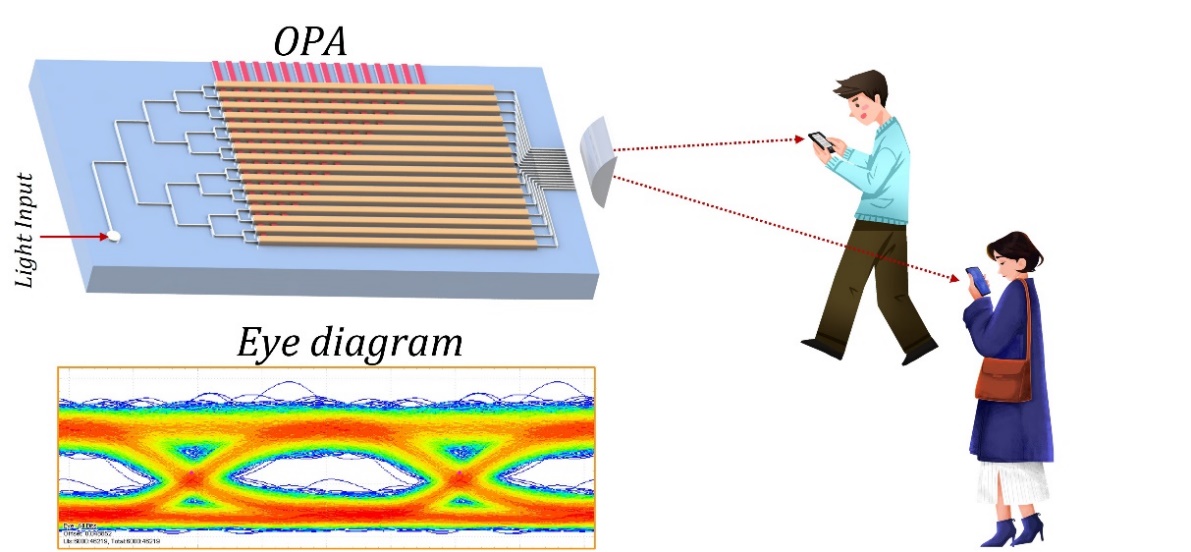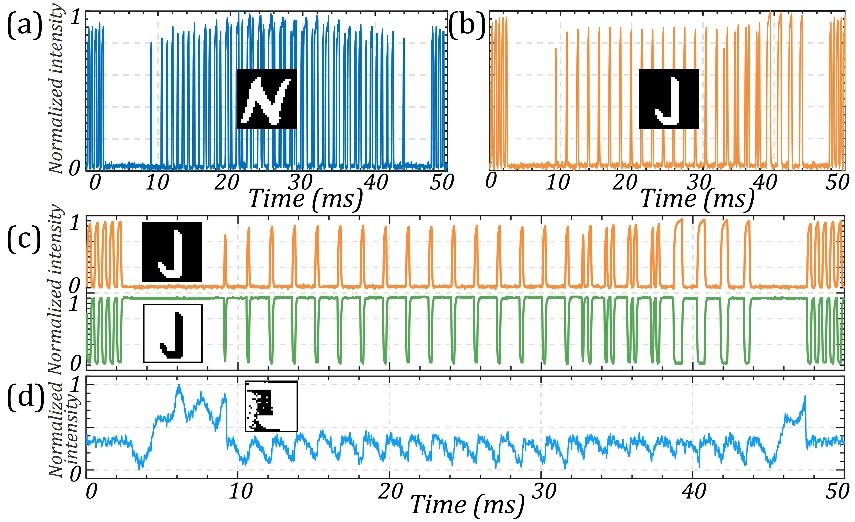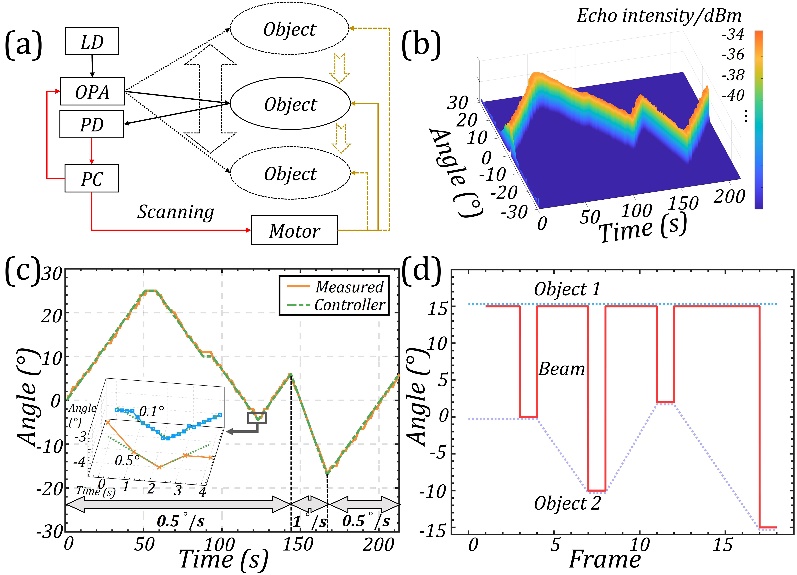Silicon based optical phased array for mobile wireless optical communications
Silicon optical phased array (OPA) is an optical wave control device integrated on silicon photonic chips. It controls the propagation direction of far-field beams without mechanical motion, which can avoid the issues of slow response and poor reliability of traditional mechanical components. Owing to their expected fast speed and high accuracy, optical phased arrays have great potential in applications such as wireless optical communications and LiDAR. Among them, indoor wireless optical communication systems based on silicon-based optical phased arrays are expected to provide users with high-speed and convenient data communication services in scenarios such as offices and conference rooms. In the application of indoor wireless optical communications, there are often situations where the user's spatial position moves rapidly and the system needs to switch the signal path quickly between multiple users (Fig. 1). Existing silicon-based optical phased arrays cannot cope with these dynamic wireless optical communication scenarios involving mobile users. To find a solution for the dynamic connection problem of mobile users and multiple users in indoor optical communication networks, the Silicon Optics Research Group at the College of Engineering and Applied Sciences at Nanjing University recently reported a silicon-based optical phased array with fast-beam-switching capability. The experiment demonstrated the advantages of silicon optical phased arrays, which may help unleash their potential in mobile optical communications.

Fig. 1 Schematic diagram of using optical phased array to support wireless optical communications for multiple mobile users with rapid switching between users. Below is the eye diagram of the 12 Gbps signal received in the experiment.
In wireless optical communication systems, signals can propagate in the form of beams, pointing towards users with a small divergence angle. Silicon based optical phased array can steer the beam to point to different users, thereby switching communication links between different users or even following the movements of users. In principle, optical phased arrays have advantages such as fast speed and no mechanical inertia, which can meet the needs of fast-beam-switching and fast moving users. However, when performing rapid beam steering at different angles, a large number of phase shifters inside the silicon-based optical phased array chip need to work synchronously in sufficient timing precision. Since the research on silicon optical phased array started in 2008, the speed demonstration has been limited to testing the phase shifting speed of a single phase shifter, and has not demonstrated the fast overall control of the beam in the time domain, making it difficult to deal with scenarios involving mobile users.
The research group has now demonstrated a wireless optical transmission architecture based on the fast-switching capability of silicon optical phased arrays. The concept is shown in Figure 1, which can provide high-speed data transmission for different indoor users. In the experiment, the phase shifters were used to control the phase of each element of the silicon optical phased array so as to control the direction of the emitted light wavefront and steer the beam. Optical signals with different lengths in time were sent to different receiving points to identify the switching between communication objects.
The experimental results proves that this system can realize wireless data transmission with bit rate of 12Gbps in the indoor environment. The transmission bit error rate (BER) was less than 10-12. The switching time between different users was smaller than 12.8μs.
To verify the stability of the complex switching sequence in the time domain, the researchers carried out the black-and-white picture transmission experiment based on the beam switching by the OPA. In the experiment, the white pixels of a picture were represented by a high level (signal "1"), and the black pixels were represented by a low level (signal "0"). With the help of the switching of optical phased array, the picture was transmitted: switching to a receiver corresponded to the signal value "1", while switching to other angles corresponded to the signal value "0", and the result is shown in Figure 2. The experiment realized the transmission of different pictures to a single receiver (Fig. 2a, b), and the transmission of complementary pictures between two receivers (Fig. 2c, d). In the experiment, the picture transmission effects under synchronous control and asynchronous control were compared (Fig. 2b vs. Fig. 2d), where the lossless picture (b) and totally lost picture (d) were obtained respectively. The visual comparison proves the importance of synchronous control of the phase shifter array.

Fig. 2 Binary pattern transmission based on switching: (a) letter "N"; (b) letter "J"; (c) the positive "J" and the negative "J" are obtained by switching between the two receivers at the same time; (d) reference experiment: failed to transmit "J" without synchronization control.
Fast and accurate positioning and real-time following for mobile users is key to wireless optical communication for mobile users. Based on the stable fast-beam-switching, the research group proposed a positioning and beam-following scheme for mobile users and carried out relevant experiments (Fig. 3). In this scheme, the silicon optical phased array emits optical signals to the moving object and its surroundings in real time, and detects the echo signal to realize the positioning and following of the target, so as to support the dynamic communication for a mobile user.

Fig.3 Positioning and following for mobile users by fast-beam-switching: (a) experimental architecture; (b) Echo intensity of the moving object; (c) comparison of measurement angle and control angle; (d) fast-switching between moving objects.
Finally, to meet the mobile needs of users in real indoor scenes, the researchers introduced a grating into the transmitting waveguide as output and used the wavelength to deflect the elevation angle of the beam to enhance the capability of the one-dimensional optical phased array, which further demonstrated the feasibility of the application of silicon optical phased array in the indoor scene.
The above results were based on the precise synchronization of phase shifters. The time domain intuitive demonstration experiment demonstrated that the silicon optical phased array can achieve fast-beam-switching, showing the feasibility and advantage of silicon optical phased array for indoor optical communication, especially for mobile users and multi-user networks. It is expected to enable new breakthroughs for the application and development of optical phased array chips.
The above results were recently published in the journal Optics Letters 49, 1961 (2024). This work is supported by the National Natural Science Foundation of China, National Key Research and Development Program of China, and Basic Research Fund of Central Universities. Ph.D student Shichong Yang is the first author of this article. Professor Wei Jiang is the corresponding author. Guihan Wu, Kaifei Tang, Fuhao Yu, Xiang Ji, Yu Xin and other graduate students have made important contributions to this work.
Journal article link: https://opg.optica.org/ol/fulltext.cfm?uri=ol-49-8-1961

